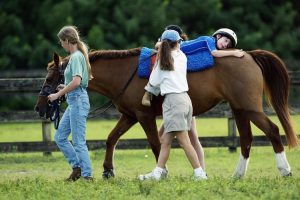Hippotherapy for Kids with Cerebral Palsy
Using animals for therapeutic purposes is really not a new idea. In fact, simply being around animals and having pets has been shown over and over again to be therapeutic in many ways.

Hippotherapy for Kids with CP
Children with cerebral palsy face various developmental struggles, with gait, balance and speech being just a few. Horseback riding, also known as hippotherapy, is a type of physical therapy that aims to improve some of these challenges – as well as teach the child innumerable skills.
It’s important to contact a developmental physician in order to get the green light on this kind of activity, as well as to know what kinds of risks you should watch out for. In this article, we’ll take an in-depth look into what exactly hippotherapy is, as well as its benefits of on a holistic level.
How it Works
Horses, historically, have helped mankind extend the amount of distance they can travel in a day, how much cargo they can carry with them and so forth. But for a cerebral palsy sufferer, the act of riding a horse can actually be very therapeutic.
Riding involves a child being on horseback with an experienced trainer. Riding is usually carried out in sessions of 30 minutes a few days each week, and the horses used in this type of therapy are specially chosen because of the demands of handling a child with cerebral palsy. They have to be gentle and specially trained to be able to make the child comfortable during the therapy.
Horses are chosen for hippotherapy because their movements target the child’s muscle groups as well as their ability to relay information back to the trainer, both of which engage the child’s physical and mental faculties. In addition, the horse’s movements encourage sensory motor integration, working on things like balance, posture and flexibility.
Riding on a horse provides an action similar to what people do when they’re walking. To some extent – anybody who has ridden a horse for any length of time can tell you – you have to use your own muscles while you are riding. Because of this, the action of riding a horse has been used as a way for people with cerebral palsy to strengthen the same muscles they would use when walking.
Of course, if you can’t walk, any means of being able to get out and enjoy some scenery is a welcome one. Being on a horse not only helps people to strengthen their muscles, improve balance and coordination, but it’s also psychologically helpful in that it’s an activity that somebody who cannot use their legs can engage in and enjoy with others. Riding is a fun way of instilling motivation in children with cerebral palsy so they’re better able to live with their condition and make strides when it comes to movement and communication.
Benefits of Riding for Children with Cerebral Palsy
Improved Overall Motor Function
Children with cerebral palsy have a hard time coordinating their movements. This is because this condition affects a part of the brain that controls movement. Horse riding activates this region of the brain, forcing it to work harder when the child is riding, compensating for the deficit as well as building new neural connections that can go a long way in helping a child move around somewhat independently.
Psychological Benefits
Children with cerebral palsy may not get the emotional connection they need from their peers or family. This is because they may have a hard time communicating these needs in an intuitive manner due to their condition. Riding helps the child open up and connect with the trained horse, helping him understand how to connect with other individuals as well as with the horse.
Independence and Confidence
Children with this condition may have had their confidence affected on account of their disability. Mastering therapeutic riding gives them an extra confidence boost since it shows them they can handle any challenges that may come in the near future.
Therapies and CP
Many of the stories about treatments and therapies for cerebral palsy involve some of the newest techniques out there. These include sophisticated surgeries, advanced pharmaceuticals and other resources that physicians and physical therapists can use to help someone with cerebral palsy. Some therapies, however, involve activities that people have been doing for thousands of years. Whether it’s riding on horseback, swimming with dolphins, or just spending time with support animals. Support animals can make a big difference in people’s lives, particularly when the child has physical limitations.
